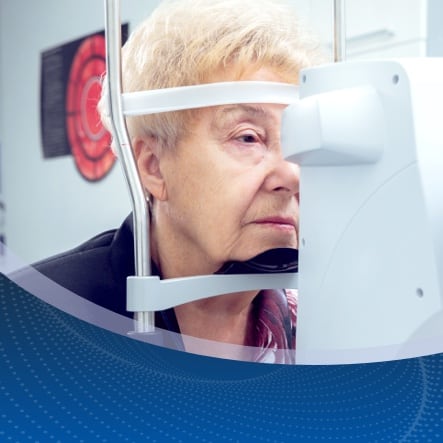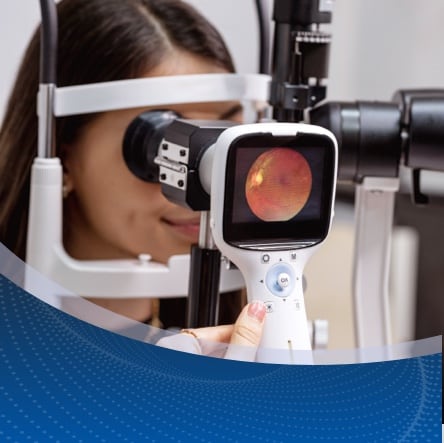Reviewed By: Dr. Paul M. Griffey
Visual static, zig-zag lines, a spreading blind spot that erases half a sentence, and an ocular migraine can turn an ordinary hour into a light show. Because the episode is usually brief and may arrive without head pain, many people shrug it off or mistake it for an eye problem rather than a neurological one. Understanding the mechanics, triggers, and warning signs helps you stay calm and know when to call the doctor.
What is an Ocular Migraine?
Doctors use ocular migraine as an umbrella term for migraine attacks that feature visual disturbances. Classic symptoms, called aura, originate in the brain’s visual cortex and appear in both eyes. A related but rarer condition, retinal migraine, affects only one eye and stems from reduced blood flow inside the retina itself.
An ocular episode lasts five to sixty minutes and may arrive with or without the throbbing head pain we associate with migraine. If the light show comes but the headache never follows, you’re experiencing an ocular migraine without headache, sometimes nicknamed a “silent” migraine. The absence of pain doesn’t mean you should ignore the event; it simply changes how you manage it.
What Does an Ocular Migraine Look Like?
Most people describe one or more of the following:
- Shimmering or flashing lights that spread outward like ripples
- Jagged, kaleidoscope-style lines
- A growing gray or blind spot that erases central vision
- Temporary vision loss from migraine that lasts up to an hour in one or both eyes
Closing your eyes won’t stop the display because it’s generated inside the brain, or inside one retina during a retinal attack. Note the time, rest your eyes, and watch how the pattern evolves; that timeline helps your doctor confirm the diagnosis.
What Causes Ocular Migraines?
Researchers haven’t pinpointed a single culprit, but most agree the root is a temporary change in blood flow or electrical activity across visual pathways. Common triggers include:
- Stress – Can stress cause ocular migraines? Yes. A surge of stress hormones can tighten vessels and excite neurons, shortening the fuse on an attack.
- Blood pressure swings – Can high blood pressure cause ocular migraines? Elevated pressure strains delicate retinal and cerebral vessels, setting the stage for a retinal or ocular event.
- Hormonal shifts – Estrogen fluctuations around menstruation, pregnancy, or menopause frequently coincide with migraine flares.
- Visual strain – Hours of unbroken screen time or intense close-up work can light the fuse.
- Environmental jolts – Bright strobe lights, dehydration, skipped meals, and certain food additives (aged cheese, aspartame) are classic sparks.
Keeping a migraine diary, including meals, sleep, stress level, and weather, often reveals patterns you can modify.
Is an Ocular Migraine Dangerous?
For most, an ocular attack is unsettling but harmless, fading without lasting damage. Still, identical symptoms can signal trouble. Are ocular migraines a sign of a serious condition? Occasionally, yes: sudden vision loss, weakness on one side, or difficulty speaking can mimic a stroke or retinal detachment. Treat any first-time or dramatically different episode as an emergency and seek care immediately.
Call your eye doctor or go to urgent care if:
- Visual symptoms persist beyond an hour
- Only one eye is affected (could be a retinal migraine or retinal detachment)
- You develop new neurological signs—numbness, slurred speech, balance issues
- Headache pain is explosive or “worst ever”
Prompt evaluation rules out eye disease, vascular problems, or neurologic emergencies.
Ocular Migraine vs. Retinal Migraine
Although the two phrases get used interchangeably, they arise from different parts of the visual pathway:
An Ocular migraine starts in the brain’s visual cortex. The shimmering pattern, zig-zag line, or expanding blind spot shows up in both eyes—even if you cover one—and usually fades within an hour. Head pain may follow, but many people experience an ocular migraine without a headache. Long-term risk to the eye itself is extremely low, though the episode can be unnerving.
A Retinal migraine, by contrast, affects the blood supply to a single retina. Vision dims, grays out, or disappears in one eye only—often for minutes. As circulation returns, sight clears. Repeated retinal events can, in rare cases, threaten the delicate tissue at the back of the eye, so report any one-sided blackout to an eye-care professional as soon as possible.
A simple at-home test helps you tell the difference: cover one eye during the disturbance. If the pattern is still there, you’re likely seeing an ocular aura generated in the brain. If the view clears, the problem is confined to the uncovered eye and could be retinal—or something even more urgent—so seek care quickly.
How to Get Rid of an Ocular Migraine
There’s no instant off-switch, but you can blunt the impact and shorten the show:
- Dim the glare. Lower lights, close curtains, and silence screens.
- Rest your eyes and mind. Sit or lie down; slow, deep breathing calms the nervous system.
- Cool compress. A cold pack on the forehead or temples eases accompanying pressure.
- Hydrate and refuel. Water and a light snack counter dehydration or low blood sugar—two common triggers.
For frequent attacks, doctors may prescribe daily preventives, beta-blockers, certain antidepressants, anti-seizure drugs, or suggest magnesium and riboflavin supplements. Controlling blood pressure, improving sleep, and scheduling screen breaks remain cornerstone habits for lasting relief.
Living Well with Ocular Migraines
While the science continues to evolve, self-management makes a noticeable difference:
- Track triggers. Apps or journals reveal patterns faster than memory alone.
- Vent stress often. Yoga, brisk walks, or two-minute breathing drills defuse pressure before it sparks an attack.
- Keep routine check-ups. Annual eye exams and regular blood pressure checks catch silent risk factors early.
- Educate your circle. A quick explanation helps family and coworkers understand why lights need dimming or why you’re stepping away from the monitor for fifteen minutes.
The Takeaway
An ocular migraine may turn ordinary vision into a temporary kaleidoscope, but it rarely signals lasting harm. Learn to distinguish its light show from the one-eyed blackout of a retinal migraine, watch for red-flag symptoms, and work with your doctor to fine-tune prevention. With trigger management and healthy routines, most people keep episodes brief, infrequent, and well within their control.
Have questions about ocular migraines? Call 1-888-873-9348 or schedule an eye exam online at our Chesapeake location. Our team is ready to support your eye health.
**Please note that the suggestions provided in this blog are for general informational purposes only and may not be suitable for your specific insurance plan and needs. It is important to consult a qualified healthcare professional for personalized advice and treatment.**












